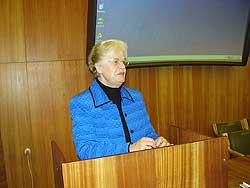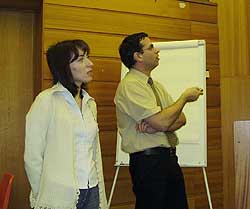
European
Nuclear Society
e-news
Issue 16 Spring 2007
http://www.euronuclear.org/e-news/e-news-16/ygn-russia.htm

The Winter School “PR Technologies: How to Work with Public and Media” was held in Rosatom’s State Regional Education Center, in St. Petersburg, on February 5 and 6 2007. The event was organized by WIN(Women in Nuclear) Global and the St. Petersburg Nuclear Society, with the support of TVEL Corporation – a Russian nuclear fuel producer. Trainers, as well as PR experts from Switzerland, Slovenia, Hungary and Bulgaria, extensively shared their experience with young specialists from various cities in Russia.

The first day featured a master class on strategic PR which from Irene Aegerter, the Honorary Chair of the Winter School and a member of the Swiss Federal Nuclear Safety Commission (SKA) and Vice President of the Swiss Academy of Engineering Science (SATW). She instructed the attendees to broadly use emotive tools along with technically "rationaled" arguments.
She stated it was impossible to answer the question “Is nuclear good or not for mankind?” using only technical arguments. The nuclear age entered human consciousness with the Hiroshima and Nagasaki bombs. It raised fears about nuclear energy that reached phobia proportions. She urged that emotions be used in order to address this psychological problem. Irene revealed her working methods and called upon experts to more actively use independent organizations and experts who were pro-nuclear and trusted by the public.

Another master class was given on Integrated Communications Approach where the Head of the Planning and Development Agency for Radioactive Waste Management, Nadja Zeleznik (Slovenia), outlined a new communications approach which had been used in the siting of a waste storage facility in Slovenia. She stressed that communications and information activities should be started as soon as possible with projects that are not always favored by the public. This would avoid potential conflicts of interests between the public and the company responsible for the construction, she noted. Nadja also described all the various tools used in the process, from the website to information placards. She concluded by saying that the use of this integrated communications approach helped to avoid conflicts and ensure that the public was adequately informed at all times.

The Hungarian Nuclear Society’s President, Tamas Pazmandi, outlined an outstanding PR initiative called the “Nuclear Tent,” which had taken place during the international music rally, on Pepsi Island, in Budapest. He described all elements of the project (educational seminars, public debates with Greens, distribution of small gifts, polls etc.) and mentioned the HNC’s Youth Section’s interaction with the public. In particular, one point of interest was the interaction with physics teachers (Scholl teachers) at the Annual Physics Teachers’ Conference. The Youth Section’s activities had a positive effect upon young Hungarians’ attitudes towards nuclear power, he said.

The Winter School’s second day was also very informative with regards to crisis PR techniques in use at the Kozloduy nuclear power plant, in Bulgaria, and the plant’s relations with the media. In the end, all Winter School attendees – who included representatives of MIFI, Mashinostroitelny Zavod, the Leningrad nuclear power plant and several nuclear industry enterprises – were given an attendance certificate. Attendees devoted their free time to strolling about St. Petersburg and socializing.
For more information about this event, refer to Tamas Pazmandi's website: portl.kfki.hu/StPetersburg.
Yekaterina Ryabikovskaya,
Winter School Organizer
![]()
© European Nuclear Society, 2007